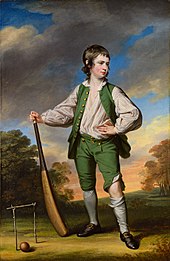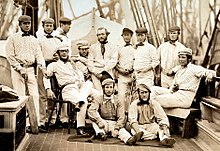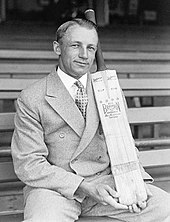Cricket can definitely be traced back to Tudor times in early 16th-century England though there have been a number of claims, many of them spurious and/or lacking evidence, supporting earlier dates from 1301. The earliest definite reference to cricket being played comes from evidence given at a 1598 court case which mentions that "creckett" (sic) was played on common land in Guildford around 1550. The court in Guildford heard on Monday, 17 January 1597 (Julian date, equating to the year 1598 in the Gregorian calendar) from a 59-year-old coroner, John Derrick, who gave witness that when he was a scholar at the "Free School at Guildford", fifty years earlier, "hee and diverse of his fellows did runne and play [on the common land] at creckett and other plaies."[3][7]
It is believed that cricket was originally a children's game but references in 1611[3] indicate that adults had started playing it and the earliest known organised inter-parish or village cricket match was played around that time.[8] In 1624, a player called Jasper Vinall died after he was struck on the head during a match between two parish teams in Sussex.[9] During the 17th century, numerous references indicate the growth of cricket in the south-east of England. By the end of the century, it had become an organised activity being played for high stakes and it is believed that the first professionals appeared in the years following the Restoration in 1660. A newspaper report survives of "a great cricket match" with eleven players a side that was played for high stakes in Sussex in 1697, and this is the earliest known reference to a cricket match of such importance.[10]
The game underwent major development in the 18th century. Betting played a key part in that development with rich patrons forming their own "select XIs". Cricket was prominent in London as early as 1707 and, in the middle years of the century, large crowds flocked to matches on the Artillery Ground in Finsbury. The single wicket form of the sport attracted huge crowds and wagers to match, its popularity peaking in the 1748 season. Bowling underwent an evolution around 1760 when bowlers began to pitch the ball instead of rolling or skimming it towards the batsman. This caused a revolution in bat design because, to deal with the bouncing ball, it was necessary to introduce the modern straight bat in place of the old "hockey stick" shape. The Hambledon Club was founded in the 1760s and, for the next twenty years until the formation of Marylebone Cricket Club (MCC) and the opening of Lord's Old Ground in 1787, Hambledon was both the game's greatest club and its focal point. MCC quickly became the sport's premier club and the custodian of the Laws of cricket. New Laws introduced in the latter part of the 18th century included the three stump wicket and leg before wicket (lbw).
The 19th century saw underarm bowling superseded by first roundarm and then overarm bowling. Both developments were controversial. Organisation of the game at county level led to the creation of the county clubs, starting with Sussex in 1839, which ultimately formed the official County Championship in 1890. Meanwhile, the British Empire had been instrumental in spreading the game overseas and by the middle of the 19th century it had become well established in India, North America, the Caribbean, South Africa, Australia and New Zealand. In 1844, the first-ever international match took place between the United States and Canada. In 1859, a team of English players went to North America on the first overseas tour.
The first Australian team to tour overseas was a team of Aboriginal stockmen who travelled to England in 1868 to play matches against county teams.[11] In 1862, an English team made the first tour of Australia. The most famous player of the 19th century was W. G. Grace, who started his long and influential career in 1865.
In 1876–77, an England team took part in what was retrospectively recognised as the first-ever Test match at the Melbourne Cricket Ground against Australia. The rivalry between England and Australia gave birth to The Ashes in 1882 and this has remained Test cricket's most famous contest. Test cricket began to expand in 1888–89 when South Africa played England.
The last two decades before the First World War have been called the "Golden Age of cricket". It is a nostalgic name prompted by the collective sense of loss resulting from the war, but the period did produce some great players and memorable matches, especially as organised competition at county and Test level developed.
The inter-war years were dominated by one player: Australia's Don Bradman, statistically the greatest batsman of all time. Test cricket continued to expand during the 20th century with the addition of the West Indies, India and New Zealand before the Second World War and then Pakistan, Sri Lanka, Zimbabwe and Bangladesh in the post-war period. South Africa was banned from international cricket from 1970 to 1992 as part of the apartheid boycott.
Cricket entered a new era in 1963 when English counties introduced the limited overs variant. As it was sure to produce a result, limited overs cricket was lucrative and the number of matches increased. The first Limited Overs International was played in 1971. The governing International Cricket Council (ICC) saw its potential and staged the first limited overs Cricket World Cup in 1975. In the 21st century, a new limited overs form, Twenty20, has made an immediate impact.
While some English team games like hockey and football became international games, played all over the world, cricket remained a colonial game, limited to those countries that had once been a part of the British empire. The pre-industrial oddness of cricket made it a hard game to export. It took root only in countries that the British conquered and ruled. In these colonies cricket was established as a popular sport either by white settlers or by local elites who wanted to copy the habits of their colonial masters, as in India.




No comments:
Post a Comment